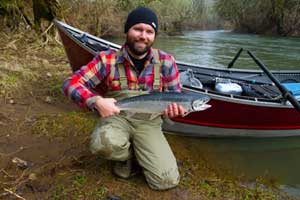Rainbow Trout Features and Size

Rainbow Trout have an elongated, laterally compressed body with a rounded snout, which becomes extended and the lower jaw turns up in breeding males as is common with other salmonidaes.
Colors
The back, upper sides and the top of the head are steel blue, blue-green, yellow-green to almost brown. The sides are silvery, white or pale yellow-green to grey and marked with a pink blush to red band and many small black spots.
The underside of the Rainbow Trout is silvery, white or grey to yellowish in color.
Dorsal and caudal fins have radiating rows of black spots, while the remaining fins are buff with few spots.
Stream dwelling and spawning brown trout are darker with more intense colors. Whereas lake residents are lighter, brighter and more silvery.
*Steelhead Trout live longer than 11 years, reaching sexual maturity at as early as year 2.
Rainbow Trout have the same life expectancy and begin spawning at year 2 also.
Trout Identification: Steelhead and Rainbow Trout
Steelhead Trout have the ability to adapt to icing full time in freshwater in the same way as Rainbow Trout are able to adapt to migrating to the sea if their habitat changes.
Prior to 1988, the Steelhead and Rainbow Trout were classified as separate species. The Steelhead Trout was classified as Salmon gairdneri while the Rainbow Trout was classified as Onocorhynchus.
Essentially there are no major differences between them and they’re the same species. Any differences have more to do with the environmental factors rather than genetic.
- Steelhead trout live longer
- Steelhead trout are also larger. However this is a common characteristic of sea-run fish over their freshwater counterpart
- Steelheads also changes color over its life where the Rainbow doesn’t
- Steelheads have a more slender appearance than the Rainbow
While at sea, Steelhead Trout feed heavily upon juvenile greenling, squids and amphipods. The reason for the change in appearance appears to be hybridization between Steelhead Trout and Rainbow Trout in the fisheries that stock the rivers and lakes. The hatchery steelhead smolt is not as robust as the wild spawned.
There’s genetic alteration of the ‘hatchery raised’ steelhead.
Size and Weight
Rainbows reach a length of 12 to 30 inches. The average weight is 2 to 5 lbs/1 to 3 kilograms.
The all-tackle record for the largest Rainbow Trout is 48 pounds. This enormous fish was caught on September 5, 2009 in Alberta, Canada by Sean Konrad using a X-Rap Jointed Shad with a Bonito color pattern. Of interest, he was using a 9’6″ Shimano Clarus spinning rod with an ABU Garcia Cardinal reel.
Steelhead Trout grow up to 45 inches/114 centimetres and can reach 55 lbs/25 kilograms according to many sources from NOAA to federal and state information sources. However, we haven’t found records of anyone that has caught one this size.
The largest Steelhead Trout caught according to the IGFA was a 42 pounder caught by David White.




